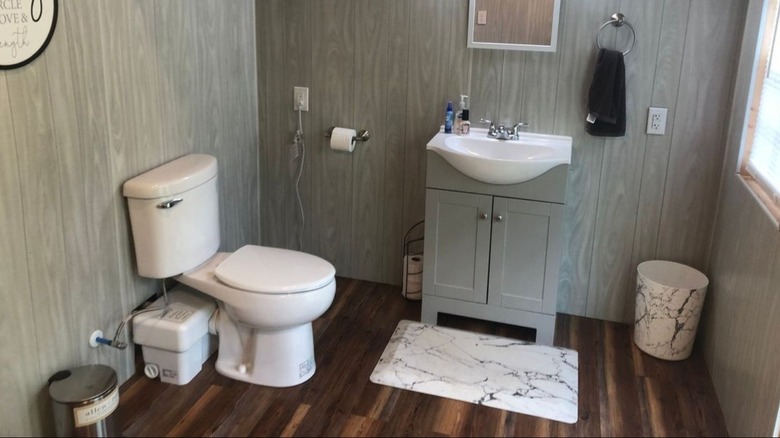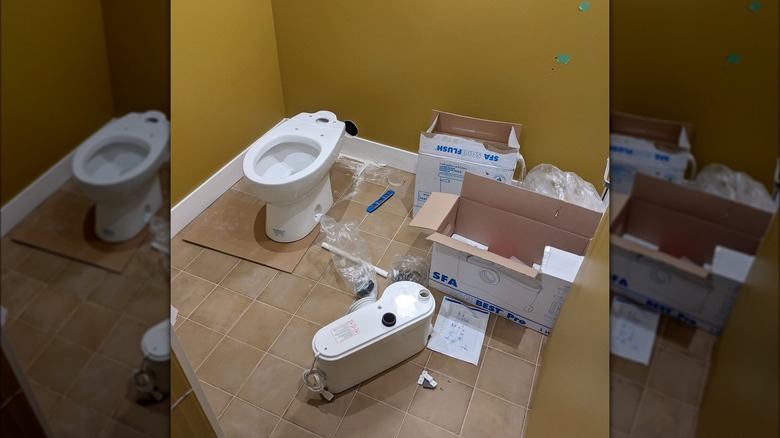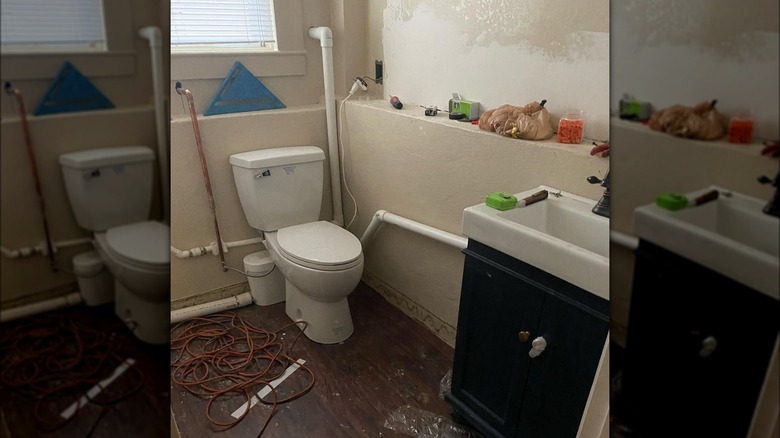Read This Before Installing An Upflush Toilet
Even if they look similar, not all toilets are created equal. That's especially true of an upflush toilet. For the most part, they appear to be just like their traditional toilet counterparts, just with some additional baggage. Joseph Wade, VP of Operations at Benjamin Franklin Plumbing, exclusively told House Digest what makes these toilets unique and where they fit into a house's scheme.
"An upflush toilet is a type of toilet that pushes waste through a pipe connected to the back of the toilet, grinds it down, and then sends it into your main sewer line or septic tank," he explained. "Upflush toilets are also commonly referred to as macerating toilets — this is because the pump that the waste is sent through is called a macerating pump (which uses a blade to cut and break down that waste into a fine slush)." Unlike a traditional toilet, this version shoots the waste upwards rather than downwards, he added.
Wade also shared that another big difference is that upflush toilets need electricity to make the pump function properly. They are also connected to a separate set of piping over the main plumbing pipeline in your home, which makes them ideal for areas that are harder to pipe to. That's why your basement bathroom is an ideal location for an upflush toilet.
Pros and cons of an upflush toilet
Bathrooms can mean serious business. That's why choosing the perfect toilet for yours isn't necessarily the easiest task. Although these maintenance tips can help keep a range of toilets in top shape, not every toilet suits every bathroom. Joseph Wade exclusively told House Digest that flexibility is what makes an upflush toilet such a terrific option. Outside of the installation possibilities in less convenient areas of a home, they're also easier to tackle. He also added, "The installation process is much less extensive and will take a professional plumber much less time than a traditional toilet would."
That said, not everything with an upflush is an upshot. Despite being easier to install, Wade still suggests bringing on a professional for installation and maintenance to avoid costly repairs later on. Part of the reason for that is they're more temperamental than traditional toilets. "They require more maintenance and servicing than traditional toilets, have a shorter lifespan, and, as previously mentioned, require electricity to work," Wade said.
Keep in mind, too, that an upflush toilet also requires a venting system. Wade explained that this vent can be worked into your existing plumbing ventilation system, but it is necessary for the toilet to have proper drainage.
Who should get an upflush toilet?
You have a lot to consider when adding a bathroom to your basement or other further-removed parts of the house. Joseph Wade shared exclusively with House Digest that these more tricky installation locations, ones that are further from the main plumbing stack, are one of the ideal reasons to install an upflush toilet. He added they're also good options for anyone looking to save some money, do less installation work, and work in an area where more traditional plumbing installation would be too difficult.
What an upflush toilet is not, however, is the easy way out. "...if you prefer a low-maintenance option, have reliable access to traditional plumbing, or live in an area prone to power outages, a traditional toilet might be a better fit," Wade explained. "Ultimately, an upflush toilet provides flexibility and ease of installation that can be a game-changer for home renovations and expansions." Despite some of its inconveniences, he acknowledged that an upflush toilet is still an excellent choice for many homeowners. He reiterated that it is always a good idea to work with professionals instead of installing or repairing it yourself.


